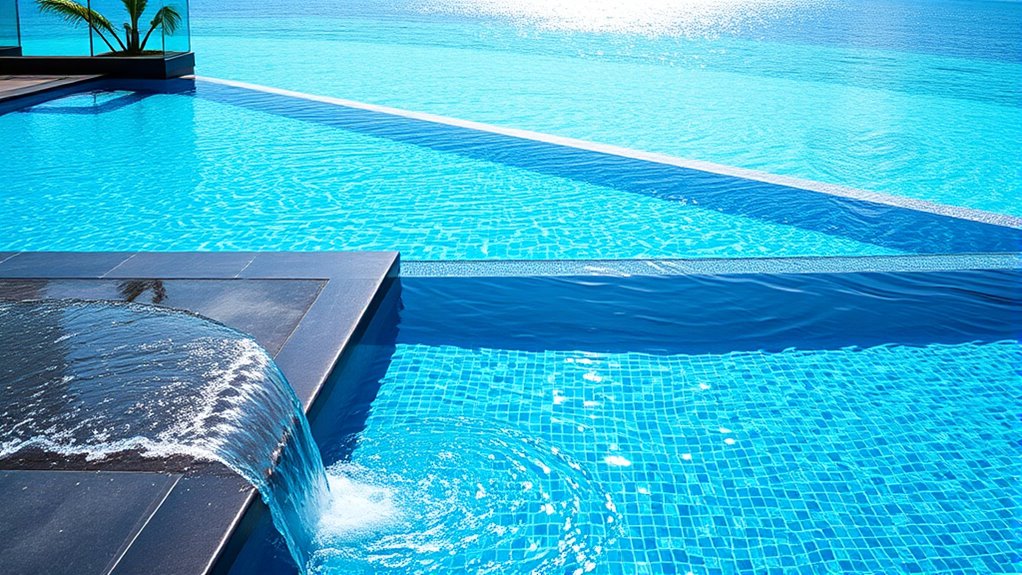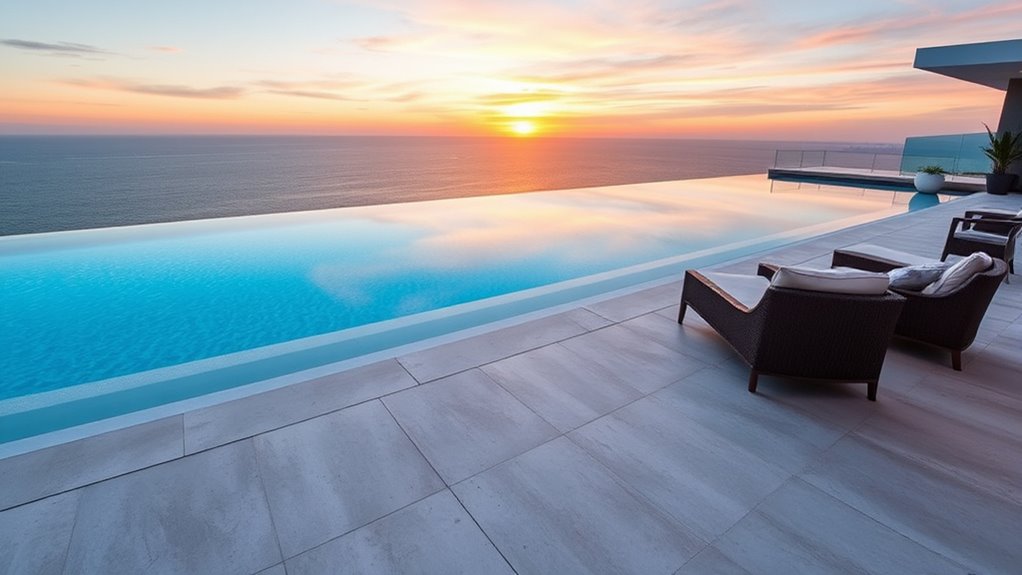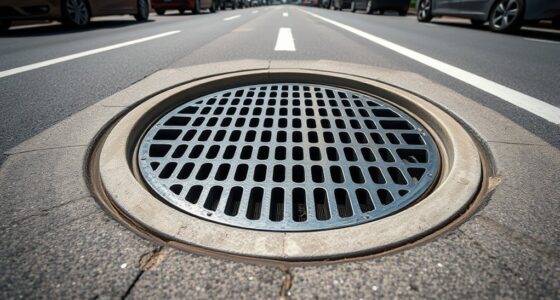If you’re choosing between an infinity pool and a perimeter overflow, consider your style, budget, and how much upkeep you’re willing to handle. Infinity pools create a stunning, seamless look perfect for scenic views but cost more to build and maintain. Perimeter overflow pools are simpler and often cheaper, offering a dynamic water feature with less hassle. To explore their visual impact, costs, and maintenance needs in detail, keep going for an all-encompassing comparison.
Key Takeaways
- Infinity pools offer a seamless horizon view and luxurious aesthetic but require higher upfront costs and more intensive maintenance.
- Perimeter overflow pools feature dynamic waterfalls and easier upkeep, with lower installation expenses.
- Infinity pools demand careful water level management and frequent cleaning of overflow troughs, increasing operational costs.
- Perimeter overflow pools have simpler construction, reducing initial investment and ongoing maintenance efforts.
- Both pool types enhance outdoor aesthetics, but infinity pools suit scenic modern settings, while perimeter overflow pools highlight architecture and texture.
Design and Aesthetic Appeal

When it comes to design and aesthetic appeal, both infinity pools and perimeter overflow pools create striking visual impressions, but they do so in different ways. An infinity pool offers a seamless edge where water appears to merge with the horizon, giving you a sense of boundless space. This design is perfect for scenic locations or modern landscapes, emphasizing luxury and elegance. Meanwhile, a perimeter overflow pool features a continuous edge where water gently cascades over the sides, creating a calming, waterfall-like effect. It adds a dynamic visual element, highlighting the pool’s structure and surrounding architecture. Both designs elevate your outdoor space, but your choice depends on whether you prefer the illusion of endless water or a flowing, textured water feature. Additionally, the visual impact of each design can significantly influence the overall ambiance of your outdoor environment.
Maintenance Requirements and Costs

Maintenance requirements and costs for infinity pools and perimeter overflow pools can vary considerably, impacting your long-term investment. Infinity pools often need more frequent cleaning of the overflow trough and careful water level management, which can increase maintenance. Perimeter overflow pools generally require less upkeep but still need regular skimming and chemical balancing. Additionally, understanding the heat distribution capabilities of each design can influence ongoing operational costs.
| Maintenance Task | Infinity Pool | Perimeter Overflow |
|---|---|---|
| Water Quality Checks | Weekly | Weekly |
| Overflow Trough Cleaning | Monthly | Less frequent |
| Pump & Filter Checks | Bi-weekly | Monthly |
| Chemical Balancing | Weekly | Weekly |
Budget Considerations and Installation Expenses

Installing an infinity pool typically involves higher upfront costs compared to a perimeter overflow pool due to its complex design, specialized construction requirements, and additional features like the overflow trough and advanced water management systems. You’ll need to budget for custom excavation, reinforced structural elements, and precise tiling to achieve the seamless edge. These factors increase labor and material expenses. In contrast, a perimeter overflow pool generally has simpler construction and less specialized equipment, reducing initial costs. Keep in mind, ongoing maintenance and operational expenses can also influence your overall budget. While an infinity pool offers a striking visual appeal, it requires a larger investment upfront. Additionally, understanding the local building codes and permits involved in pool installation is crucial to ensure compliance and avoid legal issues. Carefully assess your budget and long-term financial plan before deciding, ensuring you’re prepared for both installation costs and future upkeep.
Frequently Asked Questions
How Do Safety Features Differ Between Infinity Pools and Perimeter Overflows?
You’ll find safety features differ mainly in design. Infinity pools often have higher edges, so you need sturdy barriers or alarms to prevent accidental falls. Perimeter overflows typically have less dramatic edges, making them safer without extra barriers. Both pools should have non-slip surfaces and proper fencing. You’re responsible for ensuring safety measures are up to code, especially around the edges, to prevent accidents and enjoy your pool worry-free.
Which Pool Type Offers Better Environmental Sustainability and Water Conservation?
You’ll find that perimeter overflow pools are generally more environmentally sustainable and conserve water better than infinity pools. This is because overflow pools continuously circulate and filter water, reducing waste and evaporation. Infinity pools often require more frequent refilling due to higher evaporation rates and less efficient water circulation. By choosing a perimeter overflow, you can enjoy a stunning pool while minimizing water use and reducing your environmental impact.
Are There Specific Climate Considerations for Installing Each Pool Type?
You should consider climate when installing an infinity or perimeter overflow pool because nearly 60% of pool owners report higher evaporation rates in hot, dry climates. For infinity pools, high temperatures increase water loss, so you’ll need a robust cover and efficient filtration. Perimeter overflow pools are somewhat less affected but still require proper planning for evaporation and temperature control to maintain water levels and energy efficiency.
How Do Noise Levels Compare Between Infinity Pools and Perimeter Overflow Pools?
You’ll find that perimeter overflow pools tend to be noisier than infinity pools because of the open-edge design that often incorporates a continuous water flow. Infinity pools generally produce less noise since the water cascades silently over the edge, creating a calming effect. If noise levels are a concern, an infinity pool might suit you better, as it offers a more tranquil experience with minimal sound disturbance.
What Are the Long-Term Durability Differences Between the Two Designs?
Think of durability like a sturdy oak tree versus a delicate fern. Infinity pools typically have more durable finishes and structural elements because they’re built to withstand constant water pressure and environmental changes. Perimeter overflow pools may require more maintenance over time due to water splashing and evaporation, which can impact their longevity. Overall, infinity pools often offer better long-term durability if properly maintained, giving you peace of mind for years to come.
Conclusion
So, whether you’re captivated by the sleek allure of an infinity pool or the understated elegance of a perimeter overflow, remember that beauty often comes with a hefty price tag—and maintenance surprises. Ironically, what seems like a simple choice can turn into a costly obsession. In the end, you’ll likely find that the true luxury isn’t just in the design, but in the patience and wallet you’re willing to invest.










